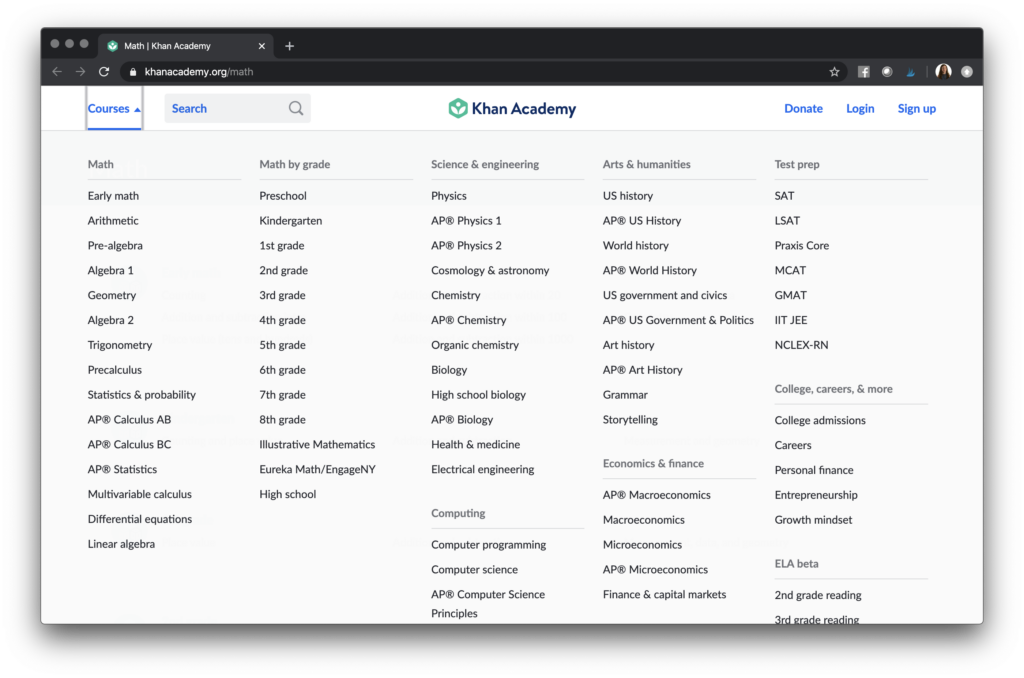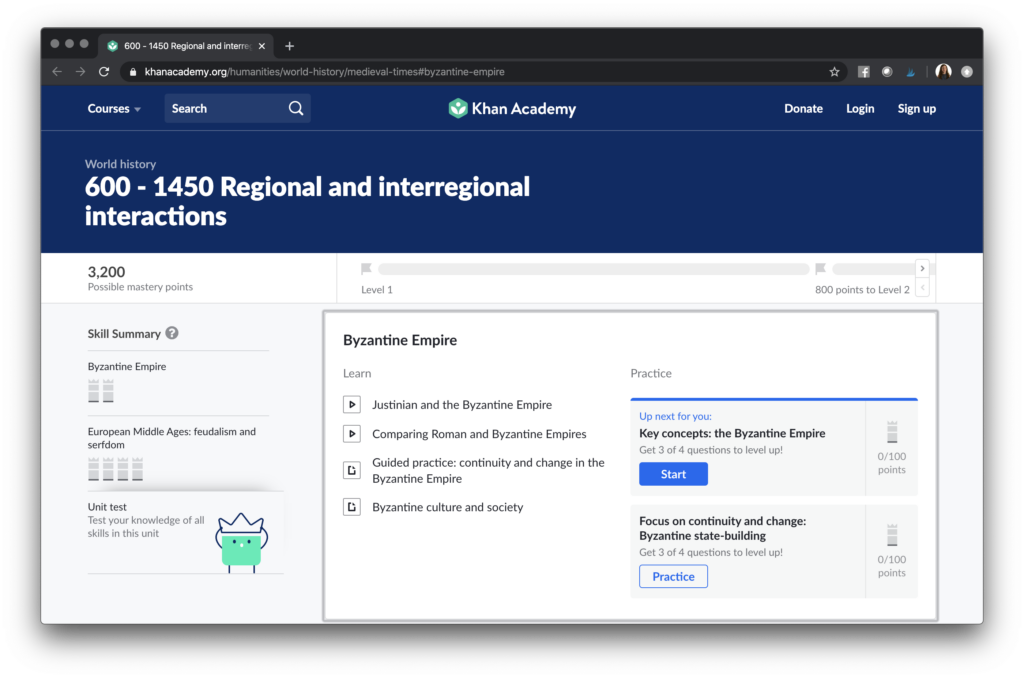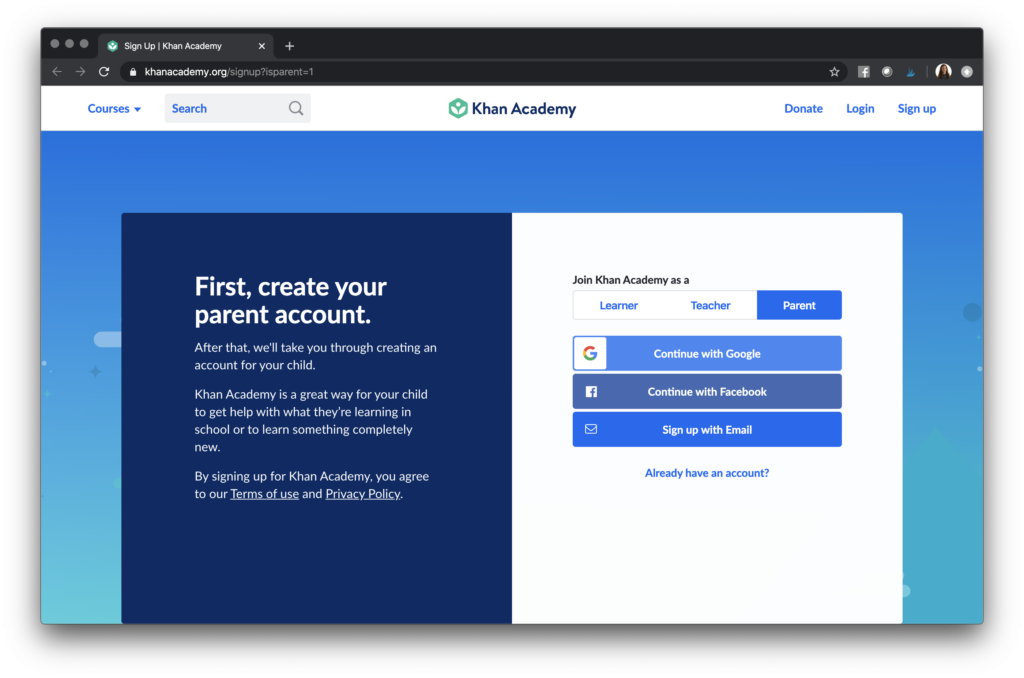I’m not sure when I really came across Khan Academy for the first time. In many ways it seems like it has been around forever, at least where conversations on EdTech integration, video tutorials, and flipped learning is concerned. Today I’ll share what Khan Academy is, and six things you might not know about it, even if you’ve used this resource in the past.
Let’s start off with the what, what is Khan Academy, and then our six things will tackle some more of the what — along with reasons why you might want to check out or dive back into this resource.
Khan Academy
Here’s the description Khan Academy gives on their about page:
Khan Academy offers practice exercises, instructional videos, and a personalized learning dashboard that empower learners to study at their own pace in and outside of the classroom. We tackle math, science, computer programming, history, art history, economics, and more. Our math missions guide learners from kindergarten to calculus using state-of-the-art, adaptive technology that identifies strengths and learning gaps. We’ve also partnered with institutions like NASA, The Museum of Modern Art, The California Academy of Sciences, and MIT to offer specialized content.
You can pull up Khan Academy straight from their website at KhanAcademy.org. This page is accessible from any device and you might decide to download one of their mobile apps. All you have to do is go to the App Store on your device and search for Khan Academy to find the right app.
If you want to listen to these tips, check out this podcast episode where I talk all about it. It’s called: Six Things You Might Not Know About Khan Academy.
Wide Range of K-12 Content
On our list of six things you might not know about Khan Academy, #1 is that Khan Academy covers a wide range of K-12 content, it’s not just high school videos. Although you might have heard Sal Khan on 60 minutes, or giving a keynote presentation, to learn a bit about the origin of Khan Academy, this platform is way more than math tutorials. It might have started out this way, and yes, Khan Academy has lots and lots of math tutorials — with topics I frankly haven’t thought of since I was a high school student — but it is so much more than high school math tutorials.
This is a resource that originally had a high school, or advanced math vibe, that has moved away from this one category. There is content for students of all ages — making it a great option for K-12 classrooms. When you open up Khan Academy a drop down menu will help you find content related to the topics taught at different grade levels.
It makes it a quick resource if you are searching for a video to help support a student who might struggle with a strategy you thought they had learned in a previous grade, but know they could use the help with. The Math section on Khan Academy for example, starts with Preschool and goes all the way to High School and even has sections for Eureka Math and EngageNY Math programs.
So first on our list, Khan Academy is more than just for high schoolers. It has content for K-12. This brings us to the second thing you might not know about Khan Academy. It’s not just math, it has resources for students in all subject areas.
All Subject Areas
On Khan Academy’s website you’ll find resources for essentially all K-12 subject areas. There are resources for students learning economics, fractions, world history, you name it. All you have to do is head to Khan Academy’s website to see the full list of what they have to offer.
Straight from their landing page, without even creating a login, you can select the drop down menu labeled “Courses.” In addition to content organized by grade level needs, like I mentioned earlier, you’ll also find content that connects to science, social studies, English Language Arts, and more. Now all of the math content we typically associate with Khan Academy is there, too, but you’ll realize right away that there is way more than just math videos going on here.

In addition to their beta ELA content for 2nd through 8th grade, there is a section for biology, US government and even Hour of Code Resources.
When you click on a topic you’ll be taken to a special landing page. Here is where you’ll find videos and additional resources around the topic… which brings us to #3 on the list. You might not know that Khan Academy has more than just video resources on their site.
More Than Just Videos
Although the origin story of Khan Academy might have started with videos, there are now lots of resources on their website that go along with each topic. For example, if I go to the Courses drop down menu which I mentioned before, choose World History, and then choose Byzantine Empire, there are two videos, and two articles with questions built in to check for understanding. The videos also have closed captioning options.

Of course, video tutorials and overviews still feel like the heart of Khan Academy, and I love their video resources and using videos with students in general.
Earlier this year in my Easy Ed Tech podcast Episode 034- Ways to Use Video Playlists in the Classroom, I shared tips for creating video playlists. And in Episode 002- How To Use Explainer Videos in Your Classroom I talked about explainer videos. If you’re interested in learning more about differentiating instruction with multimedia content like videos, you’ll want to check my EasyEdTech Podcast, too.
Classroom vs. Individual
Students can use Khan Academy individually or as an organized class. What does this mean? Well a student can go to Khan Academy’s website and search for material that might help them better understand a topic — so more self-directed learning. Or a teacher or tutor can find a video and share it directly with one individual student who might benefit from diving into these types of materials.
The other option is still focusing on an individual but more as a classroom initiative. Teachers can set up an account and assign practice exercises, videos and articles. Teachers can find the content that meets the needs of every student in a class and/or individual students. Then they can track student progress as they move through the materials. It’s a great way to use Khan Academy in a more organized way — although you might be really happy using it as needed as opposed to all of the time.
Family Sharing
In addition to number 4 on our list, the classroom and individual use, number 5 on our list of six things you might not know about Khan Academy are the family connections available on their platforms. What do I mean when thinking about family connections? Well there are several different use cases for Khan Academy when it comes to family use.
Parents can sign up for their own account straight through Khan Academy’s homepage. This allows them to then set up Khan Academy for their own child. This is a great option for teachers who aren’t using Khan Academy in their classroom but want to recommend it as a resource for families.

You might also decide to handpick two or three videos that connect to content you’re teaching each month and share with families in a newsletter. You can frame this like, “I thought you might want a behind the scenes look at some of the concepts we’re exploring this month.” From a family perspective, it can help them better understand what is happening in your classroom and support their children as needed.
Khan Academy is Free
So the sixth and final thing on our list of things you might not know about Khan Academy is that it is totally free. A lot of EdTech tools are freemium, meaning you get some things for free and then you kind of top out and need to pay for something. Or a tool that has been free for awhile then changes their pricing model and is given a price tag.
Straight from their website, you can find their mission, too. It reads: Our mission is to provide a free, world-class education to anyone, anywhere.
Are you using Khan Academy in your classroom this year? I’d love to hear all about it! Leave a comment below or tag @classtechtips on your favorite social media platform.







